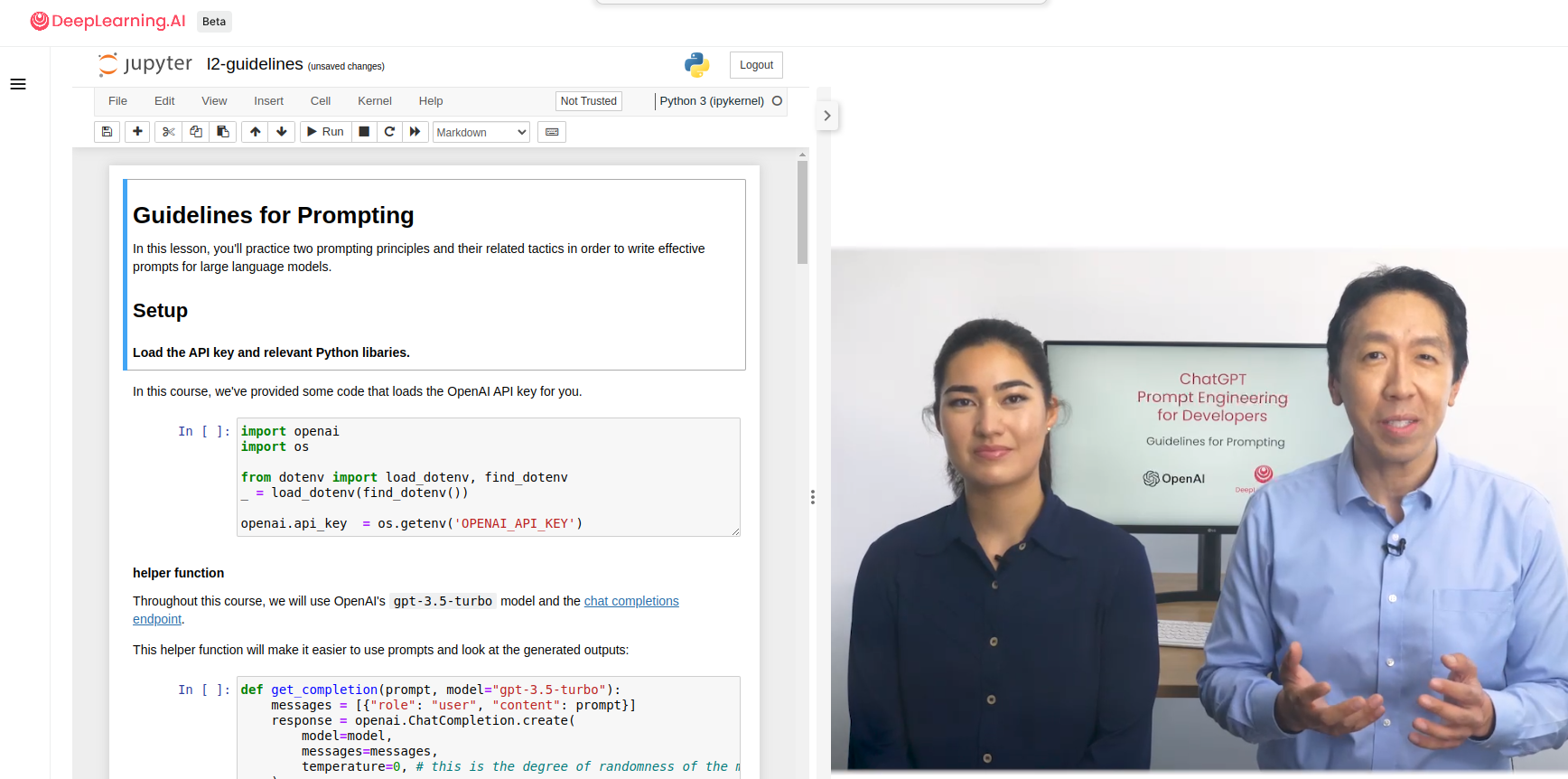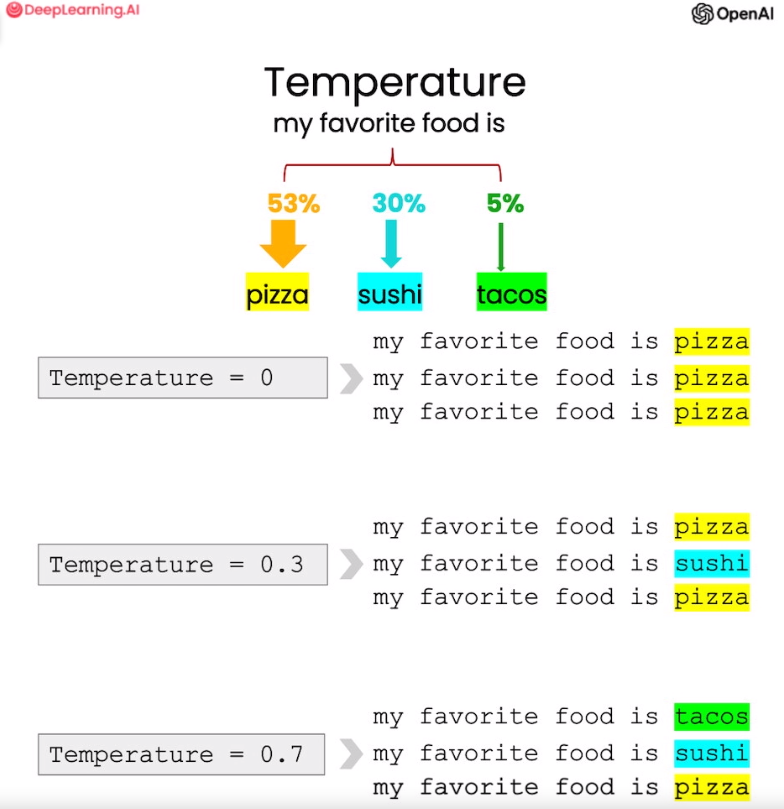Notice
Recent Posts
Recent Comments
Link
| 일 | 월 | 화 | 수 | 목 | 금 | 토 |
|---|---|---|---|---|---|---|
| 1 | ||||||
| 2 | 3 | 4 | 5 | 6 | 7 | 8 |
| 9 | 10 | 11 | 12 | 13 | 14 | 15 |
| 16 | 17 | 18 | 19 | 20 | 21 | 22 |
| 23 | 24 | 25 | 26 | 27 | 28 | 29 |
| 30 |
Tags
- ChatGPT
- python3
- Spatial GNN
- GCP
- cross-entropy
- DeepLearing.AI
- 이상 탐지
- GNN
- zachary’s karate club
- kl divergence
- Inductive Learning
- 생성 모델 평가
- Vertex AI
- 사회 네트워크 분석
- deepseek
- PSNR
- posterior collapse
- Grad-CAM
- 생성 모델
- 대칭키
- Spectral GNN
- prompt engineering
- mode collapse
- session 미종료
- SSIM
- public key
- Google Cloud
- Transductive Learning
- PyTorch
- ARIMA
Archives
- Today
- Total
데이터 과학 노트
[deeplearning.ai] ChatGPT Prompt Engineering for Developers 본문
Data Science/Machine Learning
[deeplearning.ai] ChatGPT Prompt Engineering for Developers
Data Scientist Note 2023. 6. 6. 19:27(deeplearning.ai) ChatGPT Prompt Engineering for Developers
강좌 정보
- Instructors: Isa Fulford (@OpenAI), Andrew Ng (Stanford)
- 강좌 링크
- (왼쪽) 주피터 노트북 / (오른쪽) 강좌

Introduction
- Two Types of Large Language Models (LLMs)
- Base LLM
- Predicts next word, based on text training data
- Instruction Tuned LLM
- Tries to follow instructions
- Fine-tune on instructions and good attempts at following those instructions
- RLHF: Reinforcement Learning with Human Feedback
- Helpful, honest, harmless
- Base LLM
기존에 알려진 프롬프트 엔지니어링
- 쉽고 간결하고 명확한 표현 사용 (e.g. ~ 어떻게 생각해? vs. ~에 대한 글을 1문단으로 작성해줘)
- 맥락(context)를 사용
- 모델에게 역활 (or Persona (인격)) 부여 (e.g. 너는 이제 콜센터 상담사야, 앞으로 오는 말에 상담사처럼 답해줘)
- 원하는 결과 예시를 함께 사용
프롬프팅 가이드라인 (Guidelines for Prompting)
Principle 1: 명확하고 구체적인 명력어 사용 (Write clear and specific instructions)
- clear / short
- Tactic 1: 구분 기호 사용: 따옴표, 백틱, 대시, 꺽쇠 괄호, XML 태그 (Use delimiters: triple quotes, triple backticks, triple dashes, angle brackets, XML tags)
- avoiding prompt injections
* seperate sections- Tactic 2: 구조화된 출력 요청 (Ask for structured output)
- Tactic 3: 조건 만족 여부 확인, 작업 수행에 필요한 가정 확인 (Check whether conditions are satisfied, Check assumptions required to do the task)
- Tactic 4: 작업을 성공적으로 완료한 사례를 제시 ("Few-shot" prompting; Give successful examples of completing tasks. Then ask model to perform the task)
# tactic 1
prompt = f"""
Summarize the text delimited by triple backticks \
into a single sentence.
```{text}```
"""
response = get_completion(prompt)
print(response)# tactic 2
prompt = f"""
Generate a list of three made-up book titles along \
with their authors and genres.
Provide them in JSON format with the following keys:
book_id, title, author, genre.
"""
response = get_completion(prompt)
print(response)# tactic 3
prompt = f"""
You will be provided with text delimited by triple quotes.
If it contains a sequence of instructions, \
re-write those instructions in the following format:
Step 1 - ...
Step 2 - …
…
Step N - …
If the text does not contain a sequence of instructions, \
then simply write \"No steps provided.\"
\"\"\"{text_1}\"\"\"
"""
response = get_completion(prompt)
print("Completion for Text 1:")
print(response)# tactic 4
prompt = f"""
Your task is to answer in a consistent style.
<child>: Teach me about patience.
<grandparent>: The river that carves the deepest \
valley flows from a modest spring; the \
grandest symphony originates from a single note; \
the most intricate tapestry begins with a solitary thread.
<child>: Teach me about resilience.
"""
response = get_completion(prompt)
print(response)Principle 2: 모델에게 생각할 시간 주기 (Give the model time to think)
- Tactic 1: 작업을 완료하는 데 필요한 단계 지정 (Specify the steps required to complete a task)
- Tactic 2: 성급하게 결론을 내리기 전에 모델이 자체 솔루션을 해결하도록 지시 (Instruct the model to work out its own solution before rushing to a conclusion)
# tactic 1
prompt_1 = f"""
Perform the following actions:
1 - Summarize the following text delimited by triple \
backticks with 1 sentence.
2 - Translate the summary into French.
3 - List each name in the French summary.
4 - Output a json object that contains the following \
keys: french_summary, num_names.
Separate your answers with line breaks.
Text:
```{text}```
"""
response = get_completion(prompt_1)
print("Completion for prompt 1:")
print(response)# tactic 2
- First, work out your own solution to the problem.
- Then compare your solution to the student's solution \
and evaluate if the student's solution is correct or not.
Don't decide if the student's solution is correct until
you have done the problem yourself.Model Limitations
- 환각 (Hallucination)
- makes statements that sound plausible but are not true
- reducing hallucinations
- first find relevant information, then answer the question based on the relevant information
import openai
import os
from dotenv import load_dotenv, find_dotenv
_ = load_dotenv(find_dotenv()) # read local .env file
openai.api_key = os.getenv('OPENAI_API_KEY')
def get_completion(prompt, model="gpt-3.5-turbo",temperature=0): # Andrew mentioned that the prompt/ completion paradigm is preferable for this class
messages = [{"role": "user", "content": prompt}]
response = openai.ChatCompletion.create(
model=model,
messages=messages,
temperature=temperature, # this is the degree of randomness of the model's output
)
return response.choices[0].message["content"]prompt = f"""
Tell me about AeroGlide UltraSlim Smart Toothbrush by Boie
"""
response = get_completion(prompt)
print(response)Iterative Prompt Development
- Iterative Prompt Development
- Idea / Implementation / Experimental result / Error Analysis
- ML 모델을 만들때와 유사함
- Prompt guidelines
- Be cleear and specific
- Analze why result does not give desired output
- Refine the idea and the prompt
- Repeat
- 정확한 프롬프트를 기억하는 것보다 좋은 프롬프트를 만드는 과정을 익혀야 함
- Idea / Implementation / Experimental result / Error Analysis
- Issue 1: The text is too long
- Limit the number of words/sentences/characters
- 실제로 결과를 확인해보면 수가 정확하게 맞지 않을 수 있음 (tokenizer)
- Issue 2: Text focuses on the wrong details
- Ask it to focus on the aspects that are relevant to the intended audience
- Issue 3: Description needs a table of dimensions
- Ask it to extract information and organize it in a table.
prompt = f"""
...
Use at most 50 words.
"""
prompt = f"""
...
The description is intended for furniture retailers,
so should be technical in nature and focus on the
materials the product is constructed from.
"""요약 (Summarizing)
- Summarize with a focus on _ and _
- Try "extract" instead of "summarize"
prompt = f"""
Your task is to generate a short summary of a product \
review from an ecommerce site.
Summarize the review below, delimited by triple
backticks, in at most 30 words.
Review: ```{prod_review}```
"""
prompt = f"""
Your task is to extract relevant information from \
a product review from an ecommerce site to give \
feedback to the Shipping department.
From the review below, delimited by triple quotes \
extract the information relevant to shipping and \
delivery. Limit to 30 words.
Review: ```{prod_review}```
"""
response = get_completion(prompt)
print(response)추론 (Inferring)
- Extract _ from _
- Infer 5 topics
- Alert (index) for new topic
- Extracting label (positive, negative)
- Identifing a list of emotions that the writers of the reviews
prompt = f"""
What is the sentiment of the following product review,
which is delimited with triple backticks?
Review text: '''{lamp_review}'''
"""
response = get_completion(prompt)
print(response)Extract Emotions
prompt = f"""
Identify a list of emotions that the writer of the \
following review is expressing. Include no more than \
five items in the list. Format your answer as a list of \
lower-case words separated by commas.
Review text: '''{lamp_review}'''
"""
response = get_completion(prompt)
print(response)Extract Lists
prompt = f"""
Identify the following items from the review text:
- Sentiment (positive or negative)
- Is the reviewer expressing anger? (true or false)
- Item purchased by reviewer
- Company that made the item
The review is delimited with triple backticks. \
Format your response as a JSON object with \
"Sentiment", "Anger", "Item" and "Brand" as the keys.
If the information isn't present, use "unknown" \
as the value.
Make your response as short as possible.
Format the Anger value as a boolean.
Review text: '''{lamp_review}'''
"""
response = get_completion(prompt)
print(response)Extract Topics
prompt = f"""
Determine five topics that are being discussed in the \
following text, which is delimited by triple backticks.
Make each item one or two words long.
Format your response as a list of items separated by commas.
Text sample: '''{story}'''
"""
response = get_completion(prompt)
print(response)Listen New Topics
prompt = f"""
Determine whether each item in the following list of \
topics is a topic in the text below, which
is delimited with triple backticks.
Give your answer as list with 0 or 1 for each topic.\
List of topics: {", ".join(topic_list)}
Text sample: '''{story}'''
"""
response = get_completion(prompt)
print(response)
topic_dict = {i.split(': ')[0]: int(i.split(': ')[1]) for i in response.split(sep='\n')}
if topic_dict['nasa'] == 1:
print("ALERT: New NASA story!")변화 (Transforming)
- 다국어 번역 (Universal Translator)
- Tone Transformation
- Format Conversion
- Spellcheck / Grammar check
다국어 번역 (Universal Translator)
user_messages = [
"La performance du système est plus lente que d'habitude.", # System performance is slower than normal
"Mi monitor tiene píxeles que no se iluminan.", # My monitor has pixels that are not lighting
"Il mio mouse non funziona", # My mouse is not working
"Mój klawisz Ctrl jest zepsuty", # My keyboard has a broken control key
"我的屏幕在闪烁" # My screen is flashing
]
for issue in user_messages:
prompt = f"Tell me what language this is: ```{issue}```"
lang = get_completion(prompt)
print(f"Original message ({lang}): {issue}")
prompt = f"""
Translate the following text to English \
and Korean: ```{issue}```
"""
response = get_completion(prompt)
print(response, "\n")Spellcheck / Grammar check
text = [
"The girl with the black and white puppies have a ball.", # The girl has a ball.
"Yolanda has her notebook.", # ok
"Its going to be a long day. Does the car need it’s oil changed?", # Homonyms
"Their goes my freedom. There going to bring they’re suitcases.", # Homonyms
"Your going to need you’re notebook.", # Homonyms
"That medicine effects my ability to sleep. Have you heard of the butterfly affect?", # Homonyms
"This phrase is to cherck chatGPT for speling abilitty" # spelling
]
for t in text:
prompt = f"""Proofread and correct the following text
and rewrite the corrected version. If you don't find
and errors, just say "No errors found". Don't use
any punctuation around the text:
```{t}```"""
response = get_completion(prompt)
print(response)
# Diff
from redlines import Redlines
diff = Redlines(text,response)
display(Markdown(diff.output_markdown))Expanding
- Short -> Long
- Temperature (degree of exploration (randomness))
- reliable <-> creative

- reliable <-> creative
prompt = f"""
You are a customer service AI assistant.
Your task is to send an email reply to a valued customer.
Given the customer email delimited by ```, \
Generate a reply to thank the customer for their review.
If the sentiment is positive or neutral, thank them for \
their review.
If the sentiment is negative, apologize and suggest that \
they can reach out to customer service.
Make sure to use specific details from the review.
Write in a concise and professional tone.
Sign the email as `AI customer agent`.
Customer review: ```{review}```
Review sentiment: {sentiment}
"""
response = get_completion(prompt, temperature=0.7)
print(response)Chatbot
role: system, user, assistantmessages=messages,- pizza order chatbot
import os
import openai
from dotenv import load_dotenv, find_dotenv
_ = load_dotenv(find_dotenv()) # read local .env file
openai.api_key = os.getenv('OPENAI_API_KEY')
def get_completion(prompt, model="gpt-3.5-turbo"):
messages = [{"role": "user", "content": prompt}]
response = openai.ChatCompletion.create(
model=model,
messages=messages,
temperature=0, # this is the degree of randomness of the model's output
)
return response.choices[0].message["content"]
def get_completion_from_messages(messages, model="gpt-3.5-turbo", temperature=0):
response = openai.ChatCompletion.create(
model=model,
messages=messages,
temperature=temperature, # this is the degree of randomness of the model's output
)
# print(str(response.choices[0].message))
return response.choices[0].message["content"]
messages = [
{'role':'system', 'content':'You are an assistant that speaks like Shakespeare.'},
{'role':'user', 'content':'tell me a joke'},
{'role':'assistant', 'content':'Why did the chicken cross the road'},
{'role':'user', 'content':'I don\'t know'} ]
response = get_completion_from_messages(messages, temperature=1)
print(response)import panel as pn # GUI
pn.extension()
panels = [] # collect display
context = [ {'role':'system', 'content':"""
You are OrderBot, an automated service to collect orders for a pizza restaurant. \
You first greet the customer, then collects the order, \
and then asks if it's a pickup or delivery. \
You wait to collect the entire order, then summarize it and check for a final \
time if the customer wants to add anything else. \
If it's a delivery, you ask for an address. \
Finally you collect the payment.\
Make sure to clarify all options, extras and sizes to uniquely \
identify the item from the menu.\
You respond in a short, very conversational friendly style. \
The menu includes \
pepperoni pizza 12.95, 10.00, 7.00 \
cheese pizza 10.95, 9.25, 6.50 \
eggplant pizza 11.95, 9.75, 6.75 \
fries 4.50, 3.50 \
greek salad 7.25 \
Toppings: \
extra cheese 2.00, \
mushrooms 1.50 \
sausage 3.00 \
canadian bacon 3.50 \
AI sauce 1.50 \
peppers 1.00 \
Drinks: \
coke 3.00, 2.00, 1.00 \
sprite 3.00, 2.00, 1.00 \
bottled water 5.00 \
"""} ] # accumulate messages
inp = pn.widgets.TextInput(value="Hi", placeholder='Enter text here…')
button_conversation = pn.widgets.Button(name="Chat!")
interactive_conversation = pn.bind(collect_messages, button_conversation)
dashboard = pn.Column(
inp,
pn.Row(button_conversation),
pn.panel(interactive_conversation, loading_indicator=True, height=300),
)
dashboard그 외 강좌
- ChatGPT Prompt Engineering for Developers
- LangChain for LLM Application Development
- How Diffusion Models Work
- Building Systems with the ChatGPT API
References
'Data Science > Machine Learning' 카테고리의 다른 글
| KL Divergence와 Cross-Entropy의 관계 (0) | 2025.10.09 |
|---|---|
| Gold Label vs. Silver label (0) | 2023.05.15 |
| 가능도 (likelihood) (0) | 2023.03.15 |
| Transductive vs. Inductive Learning (0) | 2022.01.02 |

